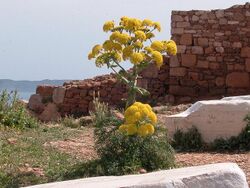Biology:Ferula communis
| Giant fennel | |
|---|---|

| |
| Scientific classification | |
| Kingdom: | Plantae |
| Clade: | Tracheophytes |
| Clade: | Angiosperms |
| Clade: | Eudicots |
| Clade: | Asterids |
| Order: | Apiales |
| Family: | Apiaceae |
| Genus: | Ferula |
| Species: | F. communis
|
| Binomial name | |
| Ferula communis | |
Ferula communis, the giant fennel,[1] is a species of flowering plant in the carrot family Apiaceae. It is related to the common fennel (Foeniculum vulgare), which belongs to the same family.
Ferula communis is a tall herbaceous perennial plant. It is found in Mediterranean and East African woodlands and shrublands.Cite error: Closing </ref> missing for <ref> tag
or narthex.[2]
Human use
Its young stems and inflorescences were eaten in ancient Rome, and are still eaten in Morocco today. However, culinary uses of this species are not always safe and poisoning may occur.[3] In Sardinia two different chemotypes of Ferula communis have been identified: poisonous (especially to animals like sheep, goats, cattle, and horses) and non-poisonous.[4] They differ in both secondary metabolites patterning and enzymatic composition.[5]
The resin of the subspecies F. communis subsp. brevifolia is called gum ammoniac of Morocco.[6]
The phenolic compound ferulic acid is named for the giant fennel, from which it can be isolated.
In Ancient Greek mythology, Prometheus gave mortals fire by hiding it in the plant's hollow stalk.[7]
Resin extraction
Since antiquity, the resin of Ferula species has been used for medicinal purposes. The resin, in the form of a sticky latex, was usually extracted from the lower stalk or root, with the root resin being the finest-grade.[8]
Where the resin of giant fennel (Ferula communis) was farmed, a small hole was pierced in its root with a sharp instrument, after clearing away all rocks and earth that cling to the exposed root. A small trench was dug beneath the root and overlayed with several smooth and flat stones at the bottom for collecting the exuded resin.[8] The piercing was made deep enough into the root or lower stalk to ensure a steady flow of resin on its own pressure.
The resin was usually harvested in the dry and hot summer months, when dampness and moisture could not corrupt the resin. The resin hardens when exposed to the air, upon which it changes color to a brownish-red. The resin that exudes in coagulated, drop-like form is considered superior to that which runs down loosely.[8]
As a tool for punishment
In the past, rods and whips for disciplinary purposes were made from the stalk of Ferula. From this usage derive the Latin ferire ("to hit")[disputed ], and also the Swedish färla (disciplinary tool used in schools in the past).[9]
References
- ↑ (xls) BSBI List 2007, Botanical Society of Britain and Ireland, https://bsbi.org/download/3542/, retrieved 2014-10-17
- ↑ Kandeler, R.; Ullrich, W.R. (2009). "Symbolism of plants: Examples from European-Mediterranean culture presented with biology and history of art: MARCH: Silphion and narthex". Journal of Experimental Botany 60 (3): 715–717. doi:10.1093/jxb/erp041. PMID 19269995.
- ↑ A Guide to Medicinal Plants in North Africa. IUCN. Centre de Cooperation pour la Méditerranée. Málaga: IUCN Centre for Mediterranean Cooperation. 2005. pp. 121–123. ISBN 2-8317-0893-1. OCLC 494618983. https://portals.iucn.org/library/sites/library/files/documents/2005-093.pdf.
- ↑ Verotta, Luisella, ed (1997). Virtual activity, real pharmacology: Different approaches to the search for bioactive natural compounds. Trivandrum, India: Research Signpost. ISBN 9788186481172.
- ↑ Zucca, Paolo; Sanjust, Enrico; Loi, Martina; Sollai, Francesca; Ballero, Mauro; Pintus, Manuela; Rescigno, Antonio (June 2013). "Isolation and characterization of polyphenol oxidase from Sardinian poisonous and non-poisonous chemotypes of Ferula communis (L.)". Phytochemistry 90: 16–24. doi:10.1016/j.phytochem.2013.02.019. PMID 23523329. Bibcode: 2013PChem..90...16Z.
- ↑ Stapf, Otto (1907). "The gums ammoniac of Morocco and the Cyrenaica. (Ferula communis, L., var. brevifolia, Mariz; Ferula marmarica, Aschers. and Taub.)". Bulletin of Miscellaneous Information (Kew, UK: Royal Botanic Gardens) 1907 (10): 375–388. doi:10.2307/4111767. ISSN 0366-4457. https://zenodo.org/record/2210619.
- ↑ Aeschylus, Prometheus Bound
- ↑ Jump up to: 8.0 8.1 8.2 Ḳrispil, Nissim (1985) (in he). A Bag of Plants (the useful plants of Israel). 3 (Ṭ.-M.). Jerusalem, IS: Cana Publishing House. p. 441. ISBN 965-264-011-5. OCLC 959573975. s.v. Ferula communis
- ↑ "färla" (in sv). 1926. https://www.saob.se/artikel/?unik=F_2023-0171.g570&pz=3.
External links
Wikidata ☰ Q150411 entry
 |


